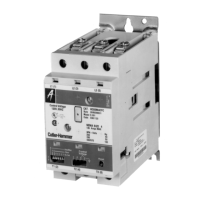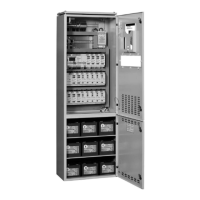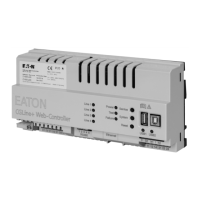IB01602009E For more information visit: www.eatonelectrical.com
Instruction Booklet
Effective: April 2006 Page 19
ATC-300 Automatic
Transfer Switch Controller
Plant Exercising in the Load Exercising Mode is “Failsafe”. If the
generator fails during testing for any reason, the ATC-300 will
signal the transfer switch to return to the Source 1 power source.
The ATC-300 will display “FAILSAFE” until a pushbutton is
pressed.
5.9 In-phase Transition (Optional Feature 32E)
The In-phase transition feature permits a transfer or re-transfer
only between 2 available sources that have a phase angle differ-
ence of eight (8) degrees or less. The In-phase transition feature
includes user-adjustable permissible frequency difference setpoint
(0.0 - 3.0 Hz) and a programmable Sync timer. The Sync times
will count down and be displayed while waiting for the two
sources to synchronize.
In-phase transition is an open transition with both sources in-
phase. An anticipatory scheme is used for controlling the circuit
breakers. The advance angle is calculated based on the fre-
quency difference between the two sources and also the
response time of the breaker. This results in the optimum recon-
nect angle of 0 degrees for all of the frequency difference values.
Both sources must be available and the frequency difference
must be less than the in-phase transition frequency difference
setpoint (0.0 to 3.0 Hz). When these conditions are met, the
ATC-300 Controller will monitor the phase difference between
the two sources. The synchronization timer will count down and
be displayed as “SYNC TIME” while waiting for synchronization
to be detected. When the phase difference is within the advance
angle window, the “transfer” command is given. This is an open
transition but both sources will be in-phase when the transfer
occurs.
If the synchronization does not occur within a specified amount
of time, the Alarm relay will energize and the failure will be
logged into the Transfer History as either “Sync Fail - Freq” or
“Sync Fail - Phase” depending on whether the frequency differ-
ence or the phase difference was excessive.
Pressing “Alarm Reset” will clear the alarm, reset the Sync timer,
and re-start the synchronization process. It is possible to force
an open transition by failing the source that is connected to the
load.
5.10 Program Mode
The ATC-300 Controller is fully programmable from the device’s
faceplate once the Password has been correctly entered. Any
operator associated with programming the ATC-300 Controller
will quickly discover that ATC-300 programming is just a matter
of simple, repetitive steps. However, because of the importance
placed on this function and its critical relationship to the proper
functioning of the system, Section 6 of this manual is dedicated
to the Program Mode. Refer to that section and Table 2 for
details.
Section 6: Programming
6.1 Introduction
ALTHOUGH ALL ATC-300 CONTROLLER PROGRAMMABLE FEA-
TURES ARE ADDRESSED IN THIS SECTION, ONLY THOSE ORDERED
BY THE CUSTOMER AND INITIALLY PROGRAMMED AT THE FAC-
TORY WILL APPEAR IN THE DISPLAY FOR PROGRAMMING CHANGES
IN THE FIELD.
The ATC-300 Controller is fully programmable from the device’s
faceplate or remotely through the communications port. Users
can reprogram setpoints as well as other parameters. The time,
date, and setpoints can only be changed while the device is in the
Program Mode.
Program Mode is achieved by entering a valid password when
prompted by the Setpoints screens. The Unit Status LED will
blink at a faster rate when viewing the setpoints while in Program
Mode.
WHILE IN THE PROGRAM MODE, THE ATC-300 CONTROLLER IS
NEVER OFF-LINE AND CONTINUES TO FUNCTION IN ACCORDANCE
WITH PREVIOUSLY PROGRAMMED SETPOINTS.
6.2 Password
To enter the Program Mode, the ATC-300 Controller requires a
password to prevent unauthorized persons from modifying set-
point values.
There are five screens related to the password, which is a four-
digit number from 0000 to 9999.
1. VIEW YES
SETPOINTS?
Use the Increase or Decrease pushbuttons to select Yes, then use
the Step/Enter pushbutton to enter the selection and move to the
next screen
2. CHANGE YES
SETPOINTS?
Use the Increase or Decrease pushbuttons to select Yes or No,
then use the Step/Enter pushbutton to enter the selection and
move to the next screen. If No is selected, the user will be able
to review the setpoints but not make any changes. If Yes is
selected, the Password screen will appear.
3. PASSWORD 0000
(Use Inc/Dec)
Use the Increase or Decrease keys to scroll to the desired value
(0 - 9) for the first digit, then use the Step/Enter key to enter the
value and move to the next digit. Repeat for remaining three dig-
its. After all four numerals of the password are entered, press
the Step/Enter pushbutton to enter the password and proceed to
the next screen. If an invalid password is entered, the LCD Dis-
play shall read “Invalid Password” and the user must press the
Step/Enter pushbutton to initiate another password entry
sequence.
Note: The factory default password is “0300”. If the password is forgot-
ten, contact the factory for the backdoor password.
NOTICE
NOTICE

